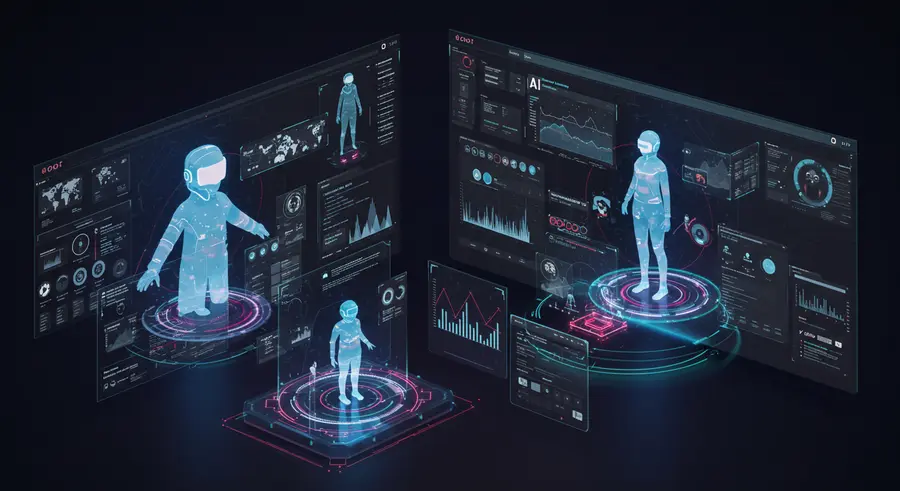Appearance

Welcome, innovators and web enthusiasts! 👋 Today, we're diving into a fascinating realm where the web meets intelligence: Computer Vision in Web Development. Imagine websites that don't just display information but understand you, react to your gestures, and adapt to your environment. This isn't science fiction; it's the rapidly evolving present, thanks to the integration of computer vision into web applications.
What is Computer Vision? 🧠
At its core, Computer Vision (CV) is a field of Artificial Intelligence (AI) that enables computers to "see," interpret, and understand the visual world. Just as human vision perceives and comprehends, CV systems process images and videos to extract meaningful information. When brought into web development, it transforms static pages into dynamic, interactive experiences.
The Power of Perception: How CV Enhances Web Interactions 🚀
The synergy between computer vision and web technologies is creating a new paradigm for user engagement. Here are some groundbreaking applications:
1. Gesture Control & Touchless Interfaces 🙌
Tired of clicking? CV allows users to interact with websites using hand gestures, body movements, or even eye tracking. This is particularly transformative for:
- Accessibility: Providing alternative navigation methods for users with mobility impairments.
- Interactive Kiosks: Public displays where users can browse or select items without physical contact.
- Gaming & Entertainment: Web-based games that respond to player movements in real-time.
Example: Imagine a virtual clothing try-on application where you simply swipe your hand to change outfits, or an educational platform where a nod confirms your understanding of a concept.
2. Augmented Reality (AR) Experiences on the Web 🌐
WebAR, powered by computer vision, overlays digital content onto the real world directly through your browser. No app download needed!
- Product Visualization: "Try before you buy" experiences for furniture, makeup, or clothing by placing virtual items in your actual space.
- Interactive Marketing: Engaging campaigns that bring static ads to life with digital overlays.
- Educational Tools: Interactive historical tours or science lessons that augment real-world objects.
Example: A furniture store's website could let you point your phone camera at your living room and see how a new sofa would look, scaled perfectly within your space.
3. Personalized & Adaptive Content 💡
CV can analyze user demographics, emotions, or attention patterns to deliver highly personalized content.
- Dynamic Layouts: Websites that adjust their presentation based on user's eye gaze or perceived emotional state.
- Smart Recommendations: E-commerce sites suggesting products based on what you're looking at or interacting with on screen.
- Contextual Information: Providing relevant pop-ups or information based on objects detected in the user's environment via their webcam (with explicit consent, of course!).
4. Enhanced Accessibility & User Experience 💖
Computer vision can break down barriers and improve the web for everyone.
- Automated Image Descriptions: Generating descriptive text for images for visually impaired users.
- Sign Language Recognition: Translating sign language captured via webcam into text for real-time communication.
- Facial Expression Analysis: Adapting content pace or difficulty in e-learning platforms based on signs of confusion or engagement.
5. Real-Time Object Recognition & Tracking 🎯
Web applications can now identify and track objects within a video stream or image, opening doors for:
- Interactive Shopping: Hovering over an item in a live stream to get product details and purchase links.
- Security & Monitoring: Simple browser-based tools for home monitoring that can detect unusual activity (e.g., package delivery).
- Inventory Management: Web tools for small businesses to quickly scan and count items using a webcam.
The Technologies Behind the Magic 🛠️
Modern web browsers, combined with powerful JavaScript libraries and WebAssembly, make these capabilities possible:
- TensorFlow.js: Enables machine learning models (including CV models) to run directly in the browser.
- OpenCV.js: A JavaScript port of the popular OpenCV library for real-time computer vision tasks.
- WebRTC: Facilitates real-time communication, crucial for accessing camera feeds.
- WebGPU/WebGL: For high-performance graphics and computation needed for complex CV tasks.
Explore Further! 🔗
To see more examples of computer vision in action and understand its broader impact, check out our catalogue page on Real-World Computer Vision Examples. It's a great resource to grasp the practical applications across various industries.
The Future is Visually Intelligent 🔮
As computer vision technology continues to advance, we'll see even more seamless and intuitive web experiences. The line between the digital and physical worlds will blur, offering users unprecedented levels of interaction and personalization. Get ready for a web that truly "sees" you!
What are your thoughts on the future of computer vision in web development? Share your ideas and let's build the next generation of interactive web experiences together!